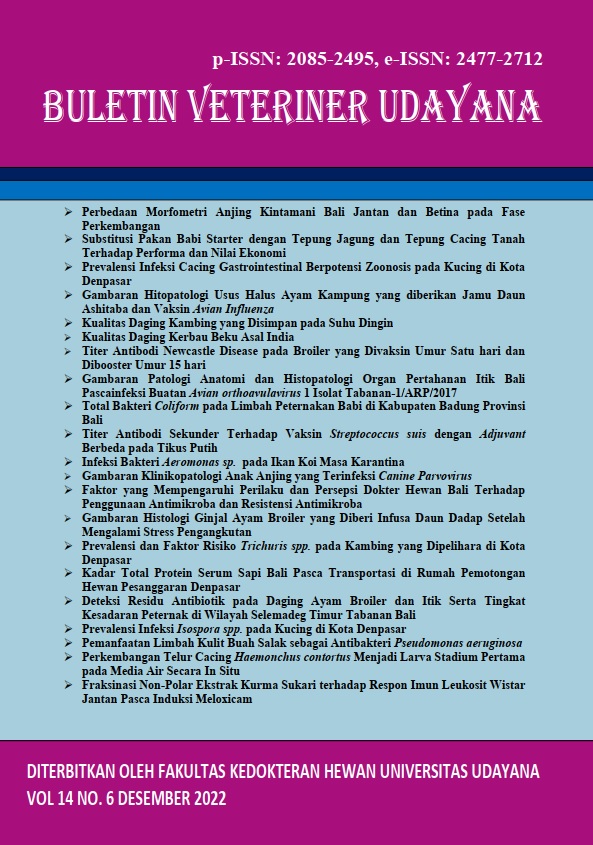DESCRIPTION OF SMALL INTESTINE HYSTOPATOLOGY OF KAMPUNG CHICKEN GIVEN HERBAL MADICINE ASHITABA AND AVIAN INFLUENZA VACCINE
Abstract
This study aims to determine the effect of giving Ashitaba leaf herbal medicine (Angelica keiskei) which was given orally against the histopathological features of the small intestine of native chickens vaccinated with Avian influenza. The sample used in this study were 25 heads day old chicken native chickens, which were divided into 5 treatment groups. The first treatment was (P0) without being given ashitaba leaf herbal medicine but given aquadest, group (P1) was given ashitaba leaf herbal with a concentration of 50mg / head / day, (P2) at a dose of 100mg / head / day, group (P3) with a dose of 200mg / head / day, and (P4) at a dose of 400mg / head / day. The treatment is carried out every day for 14 days from day 8 to day 21 which is given orally by mixing drinking water and ashitaba leaf herbal powder until the volume is 100. ml. On the 21st day, all groups of chickens were vaccinated with the vaccine Avian influenza. On the 42nd day, the experimental native chicken was necropsed, then the small intestine was taken to see changes in the histopathological structure with Hematoxylin-Eosin ( HE) staiuning. The variables examined included hydrophic degeneration, inflammatory cell infiltration and necrosis. The data obtained was tested Kruskal-Wallis. Statistical test results obtained P-value hydrophic degeneration (P = 1,000), inflammatory cell infiltration (P = 0,833) and necrotic lesions (P = 0,983). The results of this study indicate that giving the ashitaba leaf herbal medicine (A. keiskei) with a dose range of 50 mg / head / day to a dose of 400 mg / head / day for 14 days had no significant effect on the histopathological picture of the small intestine of native chickens seen from hydrophic degeneration, inflammatory cell infiltration and necrosis.
Downloads
References
Baba K, Taniguchi M, Shibano M, Minami H. 2009. The components and line breeding of angelica keiskei koidzumi. J. Bunseki Kagaku. 58(12).
Berata IK, Winaya IBO, Adi AAAM, Adnyana IBW. 2018. Buku Ajar Patologi Veteriner Umum. Cetakan ke-4. Denpasar: Swasta Nulus. Pp: 55-56.
Carlos HP, Zavala JFA, Aguilar GAG. 2011. The role of dietary fiber in the bioaccessibility and bioavailability of fruit and vegetable antioxidants. J. Food Sci. 76(1): 6–15.
Diba DF, Rahman WE. 2018. Gambaran Histopatologi Hati, Lambung dan Usus Ikan Cakalang (Katsuwonus pelamis) yang Terinfestasi Cacing Endoparasit. J. Ilmu Perikanan. 7(2): 24-30.
Fleisher D, Lippert CL, Sheth N, Reppas C, Wlodyga J. 1999. Nutrient effects on intestinal drug absorption. J. Controlled Release. 11: 41-49.
Frappier BL. 2006. Digestive System. Dellmann’s Textbook of Veterinary Histology. Oxford: Blackwell Publishing. Pp. 170-211.
Herdiani N, Putri BP. 2018. Gambaran Histopatologi Paru Tikus Wistar Setelah Diberi Paparan Asap Rokok. Med. Health Sci. J. 2(2): 7-14.
Himawan S. 1992. Kumpulan Kuliah Patologi. Jakarta:UI Press.
Inamori Y. Baba K. Tsujibo H, Taniguchi M, Nakata K, Kozawa M. 1991. Antibacterial activity of two chalcones, xanthoangelol and 4- hydroxyderricin, isolated from the root of angelica keiskei koidzumi. Chem Pharm Bul, 39(6): 1604-1605.
Mahmud ATBA, Rudi A, Damiana RE, Irma IA. 2017. Profil darah, performans dan kualitas daging ayam persilangan kampung broiler 22 pada kepadatan kandang berbeda. J. Vet. 18(2): 247- 256.
Nurcholis, Hastuti D, Sutiono B. 2009. Tatalaksana pemeliharaan ayam ras petelur periode layer di populer farm Desa Kuncen Kecamatan Mijen Kota Semarang. J. Ilmu-ilmu Pertanian. 5(2): 38-49.
Pranatha W D, Irhas R, Arhiono H N P, Widyasanti N W H, Kardena I M. 2018. Laporan kasus Newcastel Disease dan Avian Influenza pada ayam buras. Indon. Med. Vet. 7(5): 498-507.
Shackelford CC, Elwell MR. 1999. Small and Large Intestine, and Mesentar. Pathology of the Mouse Reference and Atlas. Vienna: Cache River Press. Pp. 81-115.
Song NN, Zhang SY, Liu CX. 2004. Overview of factors affecting oral drug absorption. Asian J. Drug Metab. Pharmacokin. 4(3): 167-176.
Sudarsiman. 2006. Pengaruh penggunaan vaksin H5N1 dan H5N2 virus Avian Influenza pada peternakan unggas. Balai Penelitian Veteriner. Bogor
Suhartati R, Virgianti D P. 2015. Daya hambat ekstrak etanol 70% daun ashitaba (Angelica Keiskei) terhadap bakteri Staphylococcus aureus yang diisolasi dari luka diabetes. J. Kesehatan Bakti Tunas Husada. 14(1): 162.
Sulekha S, Madhavi J, Venkateshwari A, Yasmeen S, Pratibha N. 2006. Superoxide dismutase phenotypes in duodenal ulcers: A genetic marker? Indian J. Hum. Gen. 12(3).
Swayne D. 2005. Avian influenza, poultryvaccines: a review. A Pro Med-mail post http://www.premedmail.org (Tgl. akses 3 Juni 2020)
Wiadnyana IMP, Budiasa K, Berata IK. 2015. Histopatologi usus halus mencit pasca pemberian ekstrak etanol daun ashitaba. Bul. Vet. Udayana. 7(1): 73-79.





